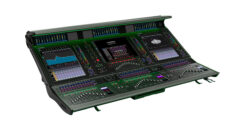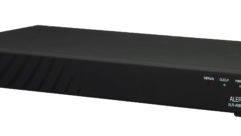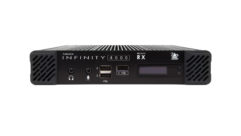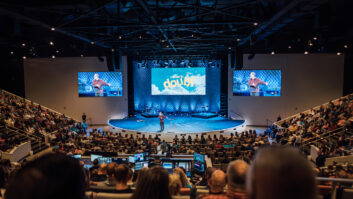
Technology Showcase:
DSP EQ Devices
Feb 1, 2006 12:00 PM,
By Mark Frink
Digital signal processing provides powerful and flexible tools.
Charts

Architectural Acoustics’ Digitool MX
In the early days of sound reinforcement, filters spaced at 1/3-octave intervals were considered sufficient to equalize a sound system (and 27 or more sliders have remained a common user interface). Parametric EQ, the modern alternative, acknowledges that equalization requirements don’t fall on regularly spaced frequencies — equalizers must vary in bandwidth. It’s not unusual to find sound professionals who feel strongly about using one set of EQ tools or another, and we frequently find products with a range of choices.
Advances in digital signal processing have allowed manufacturers to provide signal correction tools more powerful and expensive than analog devices. There are three reasons for choosing digital products: They provide users with the ability to precisely repeat or reset a device’s controls, to use those settings on identical devices elsewhere, and to remain in the digital signal environment. It’s also increasingly common to use digital in situations where speakers are self-powered and DSP is fixed inside an amplifier module.
Different types of equalizers are offered at a wide range of prices. Although several manufacturers offer a number of models, we’ve limited ourselves to one from each. Configurations range from simple stereo to 8-channel matrices that can be programmed for tasks that exceed the realms of mastering or speaker optimization.
Many provide traditional graphic filters on standard frequency centers, and some also allow users to specify the type or bandwidth of those filters. Others have parametric filters, allowing precise control of filter frequency and bandwidth, and more than a few provide both. Several have adaptive filters to sense and attenuate specific feedback frequencies quickly and automatically. Digital inputs and 24/96 resolution are found as standard features on newer products.
Some equalizers are controllable from within SIA Software’s Smaart Live, and many are controllable from a PC using proprietary software. A few have little in the way of front-panel controls, but many are programmed remotely via serial, USB, or network connections. The following programmable equalizers here in the DSP zone are presented for your consideration.

XTA’s DP428
THE OFFERINGS
Alesis’ DEQ 230D is an inexpensive 2-channel, 30-band digital graphic equalizer with 30 user memory presets and digital S/PDIF I/O on RCA connectors. It has an RTA mode that turns the twin 30-band, 13-LED gain indicators that make up its front panel into RTA displays with the option of one-second, two-second, or infinite peak hold.
Alto’s MaxiDrive 3.4 is an affordable 2×6 digital signal processor intended primarily as a speaker processor, which provides five bands of parametric equalization on its two inputs, and on its six outputs. It has combo inputs and a digital AES input on an XLR. Its 64 user presets can be programmed with PC software over a serial cable.
Apex’s Intelli-Q is a remote-controlled 2-channel equalizer with 30-band graphic and 10-band parametric, plus two bands of variable shelving and high- and low-pass filters. There are additional side-chain inputs for the dual-band compressors, which can also be used as auxiliary inputs. Up to 16 units can be controlled from a PC or tablet, and there’s an internal pink noise generator and a 48V mic input for the onscreen RTA.
Architectural Acoustics’ Digitool MX is an affordable eight-way DSP matrix. Its eight mic/line inputs, eight line outputs, and four control voltage connections appear on Phoenix connectors. Each input has phantom power; a high-pass, two-band parametric; two shelves; a gate; and a compressor. Each output has five-band, one-octave EQ at 40Hz, 160Hz, 640Hz, 2.5kHz, and 10kHz, as well as up to five seconds of delay.
Ashly’s 4.24G Protea is a 4-channel, 28-band graphic equalizer with 24dB-per-octave variable high- and low-pass filters, a compressor-limiter, and more than 1.3 seconds of delay. Up to 16 channels of EQ, including 2- and 4-channel slaves, can be controlled from the front panel, from a remote that duplicates the front-panel controls, or from a PC. Scene recall, output levels, and mutes can be controlled from an AMX NetLinx system. Balanced analog connections are available on both XLR and TRS.
Behringer’s Ultracurve is a low-cost 2-channel digital equalizer with 31-band graphic, three-band dynamic, and 10-band parametric filters. It has an onboard 61-band analyzer, a measurement mic input, and an auto EQ feature that uses the graphic settings as a target curve. Digital I/O appears on both optical and XLR connectors as AES or S/PDIF. Balanced analog is on two more pairs of XLRs, and another XLR is the RTA input for a 15V mic or line level.
Biamp’s 2-channel digital signal processor, the MSP22e, has no front-panel controls; it can be programmed from a PC and controlled using Smaart. It also provides leveling, compression, soft-gating, and a crossover mode with CD horn EQ available. Balanced analog I/O is provided on Phoenix connectors; a DB-25 allows for up to 16 contact closures. A mini-DIN allows it to be expanded with a second unit for 4×4 I/O. The processor has 24 user memories.
BSS Audio’s FDS-366 Compact PlusT is a premium 3×6 digital speaker processor intended primarily for speaker management but useful anywhere precise EQ is needed. Besides having a dynamic filter on every input and output, a budget of 53 filters allows 20 filters to be shared between the three inputs and first two outputs, and provides 33 filters for outputs 3-6. The new T version incorporates 52dB-per-octave, in-phase, flat-summation crossover slopes. Rear connections include analog I/O on XLRs, with the first doubling as the digital AES input for channels 1 and 2.
The newest dbx DriveRack, the 4800, is a 4×8 digital speaker processor employing Harman’s HiQnet networking control. Along with 31-band graphic EQ and nine-band parametric (which can be switched to a second graph) on all inputs, and six-band parametric EQ on every output, it has two DSP inserts on each I/O to provide a choice of gating, de-essing, AGC, compression, feedback suppression, and even sub-harmonic synthesis. The processor features analog and full digital AES I/O on XLRs, as well as optional CobraNet and Jensen transformers.
Inter-M’s MEQ-2000 is a 2-channel mastering or sound-reinforcement equalizer with 31-band graphic; eight-band parametric; fully variable HP, LP, and six-notch filters; and a peak limiter or compressor. An internal signal generator and RTA complete the menu. The equalizer also offers 1.3 seconds of delay. Mastering, reinforcement, and measurement configurations reorder the processing blocks. Comprehensive connectors include balanced analog XLR, digital AES, S/PDIF and TOS-link I/O, MIDI, and RS-232.

TC Electronic’s EQStation
Klark Teknik’s DN9340 Helix is a premium 2-channel equalizer with 31-band graphic; 12-band parametric; two dynamic filters; and three notch, shelf, or HP/LP filters. Five modes of graphic filters are offered: KT’s classic DN27 and DN360, plus proportional, constant, and symmetrical, each with adjustable Q. The 9344 is a 4-channel single-space slave. New E versions add networking, and the RAPIDE 100mm moving fader controller includes an eight-port hub. Wireless remote operation from a WiFi tablet PC is supported.
Lake Technology’s Mesa is a networkable, remote-controlled 4-channel equalization matrix with minimal front-panel control, typically used with a wireless tablet PC. Lake equalizers provide graphic and parametric filters in up to eight layers or groups. SmaartLive can export data to the Lake controller interface. Balanced analog I/O is on four pairs of XLRs, and digital AES is on a single DB25. The equalizer features front and rear Ethernet connections.
Peavey’s VSX 26 is an affordable 2×6 digital speaker processor intended primarily for speaker management, with 27-band input graphic, five-band output parametric, automatic feedback suppression, and an onboard RTA. Front-panel connectors include a measurement mic XLR and a USB port for a self-loading PC GUI. Presets can also be directly loaded from a memory stick. Balanced analog connectors are XLR.
Phonic’s i7600 Supracurve is an inexpensive 2-channel, 30-band digital graphic equalizer with HP/LP filters and 30 user memory presets. Sound familiar? It also uses each band’s 13 LEDs to provide an internal RTA function with variable range and response time and peak-hold. Connections include balanced outputs on XLR and TRS, and combo inputs and pink noise on an XLR.
PreSonus’ DEQ624 is a 2-channel digital graphic equalizer with analog controls. Its 31-band front-panel sliders can be selected as 6dB, 12dB, or 24dB filters, indicated by a green-, yellow-, or red-range LED. Any frequency can be selected as Hi-Q (1/8-octave). Variable HP, LP, expander, and limiter controls are also available. Front-panel controls can be stored in one of four memory locations. Balanced analog I/O is provided on XLR, TRS, and barrier strips, and has a hard-wire bypass.
Rane’s RPM 2 is a 2-channel digital signal processor with no front-panel controls that is programmed from a PC and configurable using DragNet software. Crestron and AMX control is available over Ethernet or from the contact port. Balanced analog connections and an eight-way contact port are on Phoenix connectors.
Sabine’s Graphi-Q2 is the second generation of the company’s 2-channel digital equalizer, with 12 bands of parametric or FBX anti-feedback filters, and 31 analog front-panel graphic controls. It comes in single- and dual-channel versions and with or without front-panel controls. Other features include variable HP/LP filters, a compressor, and up to a second of delay. RS-232 ports allow control from a PC or as a Smaart device. The equalizer offers balanced analog on XLR and TRS, plus a seven-contact Euroblock.
Samson’s D-2500 2-channel digital equalizer is equipped with 31 analog faders to control one or both channels’ graphic filters. The faders are not motorized, but values for each of 99 memory filters can be read in the data window. Nulling LEDs are used to restore the values’ positions. The equalizer also features variable HP/LP, a gate and limiter, and an HF enhancer. Graphics filters are available in 3dB, 6dB, or 12dB versions, with widths of 1/4-, 1/3-, or 1/2-octave. Balanced analog I/O appears on two pairs of XLRs.
Shure’s DFR22 is a software-configurable 2-channel processor. Out of the box the first few presets are dual mono or stereo 16-band digital feedback reducers, 10-band parametric and 30-band graphic EQ, a limiter, and a zeroed two-second delay. Additional processing — such as AGC, gating, compression, ducking, and crossovers — can be programmed from a PC. Balanced analog is provided on XLR and Phoenix connectors. Crestron/AMX control is via RS-232 from the DB-9 on the front or a Phoenix on the back.

Yamaha’s DME24N
TC Electronic’s EQ Station 4- or 8-channel digital equalizer features a 27-band graphic, a six-band parametric, and a three-band dynamic EQ, plus 600ms of delay and a peak-limiter for each channel. It can be operated from its front panel or from PC software and, in 64-channel networks, its graphic section can be operated remotely from the MotoFader. Balanced analog I/O is on XLRs, and an optional AES card makes digital I/O available on a DB25 connector.
TOA’s DP-0206 DACsys 2000 is a 2×6 digital signal processor with gate, compressor, and 12 bands of pre-matrix equalization. It also features 12 more bands of post-matrix EQ, including crossovers, plus full gating/compression (as before) and alignment delay. Balanced analog for two inputs and six outputs appears on Phoenix blocks, and two expansion slots each can accommodate pairs of additional analog or digital I/O, allowing expansion to 2×10 or 6×6. The processor also includes an optional eight-contact control card.
Weiss’ Gambit EQ1-MK2 mastering equalizer offers dedicated parameter-per-knob controls for seven identical parametric filters. An MS mode allows independent EQ of mid or side channels. Optional upgrades change four filters to dynamic filters or all seven to linear phase filters. Only AES digital I/O is available, with 44.1kHz to 96kHz and POW-R dithering to 16, 20, or 24 bits.
Xilica’s DSPX-8080 is an 8×8 DSP matrix processor with six parametric equalizers on each input and output, crossover slopes up to 48dB per octave, and 450ms of delay. Channels have individual select, mute five-segment LED metering, and a six-character name. Balanced analog connections for eight inputs and outputs appear on XLRs. An install version has no front-panel controls and features audio on Phoenix connectors.
XTA’s new 4×8 DSP matrix, the DP428, is designed primarily for speaker management, with 28 bands of graphic EQ and eight bands of parametric EQ on the inputs, and nine bands of parametric EQ, plus two-stage limiters and crossover slopes to 48dB per octave, on the outputs. Balanced analog I/O appears on a dozen XLRs, with digital AES also available on every other XLR.
Yamaha’s DME24N networkable digital signal processor can be expanded from 8-channel analog I/O by adding one mini-YDGAI expansion card to provide eight more analog or digital inputs and/or outputs at 96kHz. Custom configurations are built on a PC running DME Designer to construct presets from DSP building blocks. Connections include eight mic/line inputs and eight line outputs on Phoenix blocks, plus Ethernet, MIDI, and word clock I/O.
Z-Systems’ Z-Q2 is a 2-channel digital mastering equalizer with four parametric and two shelving filters. AES digital I/O is offered on XLR connectors, and MIDI can provide full control and access to 99 presets.
For More Information
Alesis
www.alesis.com
Architectural Acoustics
aa.peavey.com/
Ashly
www.ashly.com
Behringer
www.behringer.com
Biamp
www.biamp.com
Brooke-Siren Systems
www.bssaudio.co.uk
Inter-M
www.inter-m.com
Klarkteknik
www.klarkteknik.com
Lake Technology
www.lake.com.au
Peavey
www.peavey.com
Phonic
www.phonic.com
Presonus
www.presonus.com
Rane
www.rane.com
Sabine
www.sabine.com
Samson
www.samsontech.com
Shure
www.shure.com
TC Electronic
www.tcelectronic.com
TOA Electronics
www.toaelectronics.com
Weiss
www.weiss.ch
Xilica
www.xilica.com
Yamaha
www.yamahaproaudio.com
Z-Systems
www.z-sys.com
Mark Frinkis a veteran pro audio journalist and a touring concert sound engineer.










